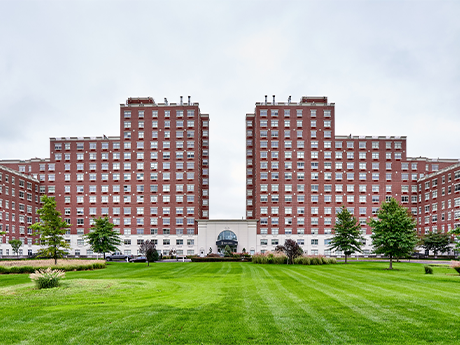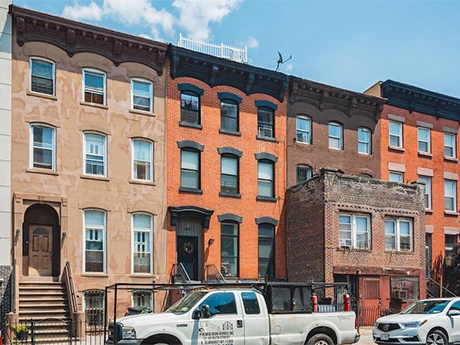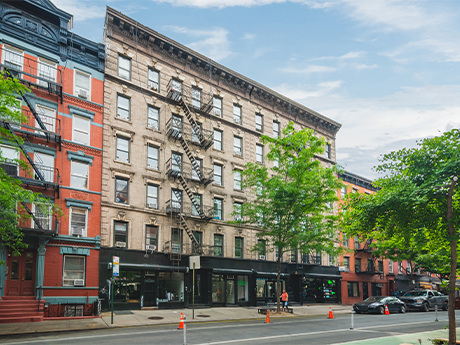Across the United States, real estate markets are in a recession for dealmakers. The run-up in interest rates over an 18-month period has choked off transactions. Potential buyers and sellers are deadlocked over price. Vulture investors are waiting for owners who paid too much for properties during boom years to be forced to sell.
New York City reflects all those trends — only more so. Many investors spent billions of dollars to buy rent-stabilized buildings in the city with plans to eventually raise the rents. But in 2019, lawmakers made the rent stabilization program much tougher. Investors are lining up to buy these overleveraged, rent-stabilized properties at deep discounts.
In the rest of the country, developers started construction on hundreds of thousands of new apartments in 2021 and 2022. Since then, the cost of debt has increased sharply, even after accounting for the recent pullback in interest rates. Developers are struggling to finish the projects they started. They are also much less equipped to start new deals.
In New York City, developers were even more eager to plan new apartment properties in order to obtain a huge break on property taxes before the Affordable Housing New York program expired. Now, developers are struggling to finish these construction projects in time to keep their precious, irreplaceable tax abatements.
As all this drama plays out, renters continue to sign leases at historically normal levels. Average, effective apartment rents are high and rising, according to RealPage.
“The city is very much alive and back from COVID — restaurants are full, the museums are full, transportation is full,” says Douglas Eisenberg, founder and CEO of A&E Real Estate. “The fundamentals of New York are fantastic for apartments. This is the best market in the world.”
Waiting for Big Discounts
A&E hopes to buy apartment properties in New York City in the first and second quarters of 2024.
“We’d like to acquire as much as we can,” says Eisenberg. “Whether we acquire one building or 10 really depends upon what type of transactions present themselves.”
Prices have already dropped significantly for the few apartment acquisitions that have closed compared with prices before interest rates began to rise in early 2022.
“There is a doorman building in Manhattan that’s 98 percent free market that’s trading at a mid-5 percent cap rate,” says Joe Koicim, partner and co-founder of the New York Multifamily Group for Marcus & Millichap.
New York has famously been a place where many investors accepted cap rates of 3 percent or even lower to buy prime apartment properties. That low cap rate has made less and less sense as all-in interest rates have risen well above 6 percent for many permanent loans. Long-term interest rates have contracted moderately since late October but are still putting upward pressure on cap rates.
“I’ve been doing this for 20 years and this is the first time in my career where I’m seeing cap rates this high,” says Koicim.
So far, relatively few deals have closed. Sales of apartment properties and portfolios in New York City totaled $4.8 billion year-to-date through October, according to MSCI. That figure pales in comparison to the average of $12 billion in annual sales of the past 10 years.
But many owners may be forced to sell — especially developers and value-add investors who often used high-leverage, short-term loans with floating interest rates to buy and build apartment properties.
Potential buyers like A&E intimately understand the pressure that many of these property owners are under.
A&E bought thousands of apartments in New York City during the pandemic and just before the Federal Reserve raised its benchmark interest rate from effectively zero before 2022 to a range of 5.25 to 5.5 percent today to combat inflation.
“It’s very hard to run properties in an interest rate environment that’s 500 basis points higher than it was and not have problems,” says A&E’s Eisenberg.
Property owners with short-term loans will face another challenge when the loans reach the end of their terms. With higher interest rates, many properties cannot qualify for a new loan large enough to pay off their existing debt.

“Yes, I expect there to be distress over the course of the next 12 months, so there will be opportunity to acquire assets that are in distress,” says Jim Simmons, CEO and founding partner of Asland Capital Partners. Investors like Asland may also find opportunities to partner with the owners of apartment properties to reduce the amount of their debt.
Other owners may be able to contribute more equity to make a refinancing possible. “We’re well-capitalized and we’re working with our partners and investors and banks to come up with solutions,” says Eisenberg.
The drama of high interest rates and forced sales is also playing out in the municipalities around New York City.
“Anyone who has a loan coming due has a real problem,” says Elie Rieder, founder and CEO of Castle Lanterra, which owns apartment properties in the Southwest, Southeast and Northeast regions of the country, including Central New Jersey and Long Island, New York. The firm also owns development sites in Florida.
Castle Lanterra also expects to buy discounted apartment properties in 2024 for owners under pressure to sell.
“There are a lot of people with floating-rate loans who will just be trying to hold on but won’t make it past another quarter or two,” says Rieder.
As of December, federal officials projected modest rate cuts starting in mid-2024. That would be too late to help many distressed borrowers, unless long-term rates recede to 2022 levels much more quickly, allowing borrowers to refinance.
Rent-Stabilized Properties Drop in Value
Inside New York City, the drama has been heightened by rent stabilization laws. The regulations restrict the increases in rents of almost half of all apartments in New York City.
Before 2019, many investors paid high prices for rent-stabilized buildings with plans to raise the rents. Under the old rules, property owners could substantially raise the rents of vacant units. So a number of these investors harassed rent-stabilized tenants to move out by neglecting repairs or creating unsafe living environments, according to the Office of the New York State Attorney General, which prosecuted several such cases.
Others planned expensive renovations, because the old rules also allowed them to raise rents after completing capital improvements. In 2019, state lawmakers passed the Housing Stability and Tenant Protection Act, which made New York’s rent stabilization program much, much tougher. In December 2023, lawmakers tightened those rules yet again. It is now nearly impossible to take apartments out of rent stabilization or substantially raise the rents, says Shimon Shkury, president and founder of Ariel Property Advisors.
Some owners claim it is impossible to profitably maintain rent-stabilized apartments under the new rule, claiming that 50,000 rent-stabilized apartments are now vacant. Landlords are allowed to raise rents enough to support $15,000 in renovations, but many rent-stabilized tenants stay in their homes 10 years or more, and when they finally leave, the apartments need much more work.
“If you’ve had someone living in an apartment for decades, you renovate the kitchen, new electric, plumbing, new floors. To create a decent place for a working family right now, it’s going to cost more than $15,000,” says A&E’s Eisenberg.
Investors like A&E will still consider buying stabilized buildings for the right price — if the buildings are in good condition. “Maybe you see a building with a really low price, but you need to replace that boiler or those windows,” says Eisenberg. “It doesn’t make economic sense.”
Other potential buyers include private investors such as family offices that have owned real estate in New York City for generations. “They have a lot of cash and a strong relationship with the banks,” says Peter Carillo, principal and senior managing director for HKS Real Estate Advisors.
It’s still not clear how much these buyers will be willing to pay. Few buyers are willing to accept cap rates that are lower than the cost of permanent financing, currently above 6 percent, says Marcus & Millichap’s Koicim. However, Marcus & Millichap is now arranging the sale of a rent-stabilized building in Queens at a cap rate of 5 percent.
“There’s some emotional buyers out there,” says Koicim. Others are willing to gamble that the rent stabilization rules will change again sometime in the future.
Experts are now picking through the details of several giant deals closed in late 2023 that should help resolve the real value of New York real estate in this era of higher interest rates. Federal officials are selling Signature Bank’s portfolio of $33 billion in real estate loans. The bank failed in early 2023 and was seized by the Federal Deposit Insurance Corp.
In December, a joint venture led by Blackstone bought a stake in a $16.8 billion piece of the loan portfolio, largely made up of performing, fixed rate loans to commercial and multifamily properties. Another partnership led by the Community Preservation Corp. bought a stake in another $5.8 billion in loans, largely to rent-stabilized properties in New York City.
“Signature did probably one in every four multifamily loans in New York City,” says Marcus & Mllichap’s Koicim.
Development Gets Even Tougher in NYC
High interest rates and scarce financing have made it extremely difficult for apartment developers to start construction across the United States. The Fed has expressed its willingness to cut rates in 2024 — but short-term rates are still 500 basis points higher than in early 2022, and many banks have stopped lending.
In New York City, planning new apartment projects is even more difficult.
In June 2022, apartment developers lost the Affordable Housing New York program. The program gave owners abatements of New York City’s high property taxes, provided they agreed to restrict the rents on at least 30 percent of the units at a property.
Since the expiration of the Affordable Housing New York program, also known as 421-a, developers have applied for far fewer building permits. They applied for permits to build just 9,626 proposed apartments from January through November 2023. That’s a fraction of the 45,162 proposed units in the same period in 2022, according to analysis from the Real Estate Board of New York.
But some developers are still planning new projects — sometimes on sites acquired at a discount after other developments failed.
“The pricing reset is happening,” says Eric Brody, managing partner at ANAX Real Estate Partners. “If you don’t start paying attention to New York, you are going to miss the opportunity.”
In summer 2023, ANAX helped a developer find debt financing to start construction on an eight-story building with 42 rental apartments in the Long Island City neighborhood of Queens, New York.
The developer bought an existing loan secured by the development site and foreclosed on that loan after an earlier plan failed to build condominiums during the COVID-19 pandemic. As of December, the developer was pouring concrete, racing against time to finish the building and keep the tax abatement arranged by the earlier, failed development, says Brody.
Other developers also plan to build super-luxurious residential buildings without the assistance of a tax abatement.
ANAX is now helping another developer arrange financing for a planned 30-story condominium tower located in the expensive neighborhoods of brownstone townhouses near downtown Brooklyn.

The developer received several offers of financing in late 2023 from alternative lenders and equity providers, says Brody.
All totaled, developers started construction on 16,410 market-rate apartment units in New York City in the first three quarters of 2023, a decrease of 20 percent from the prior year.
By comparison, the number of construction starts nationally over the same period was down roughly 40 to 50 percent, according to RealPage.
Suburban Developers Also Break Ground
Apartment developers are finding ways to start construction in the municipalities around New York City.
Developer Prime City expects to break ground in early 2024 on its plans to build 70 new apartments at 595 Lincoln Ave. in Orange, New Jersey. Local officials have approved Prime City’s site plan and the design of the development and agreed to provide a property tax abatement.
Zoning officials asked Prime City to change how the building would be positioned on the site, but in exchange they allowed Prime City to increase the height of the planned building to 75 feet and add another 10 apartments to the plan, said Alex McGee, co-founder of Prime City.
Negotiations like these help Prime City start new apartment projects despite high interest rates. In May, the company started construction on another development to build 31 new apartments near the train station in Long Branch, New Jersey, called SICA Lofts.
Developers also have a large number of new apartments under construction in places like Jersey City and South Westchester County. Those submarkets show strong renter demand — along with some sites available for development.
Developers are scheduled to open 12,054 new apartments in Jersey City, New Jersey, between 2024 and 2026, which would increase the existing inventory 15.7 percent. They plan to open 11,954 new apartments in South Westchester County in communities such as White Plains, New Rochelle and Yonkers, increasing the inventory 14.5 percent.
Absorption Rebounds
Renters are once again signing leases in and around New York City. The number of marketrate apartments with signed leases grew by 6,422 in the third quarter of 2023. It’s a normal level of absorption for the city, according to Carl Whitaker a real estate economist with RealPage.
That’s a stark reversal from the huge swings of the COVID era, when tens of thousands of renters fled the city and then flocked back. The number of occupied apartments shrank as much as 20,000 per quarter in 2020 and early 2021. Then the number of occupied apartments grew as much as 53,000 per quarter in later 2021 and early 2022, according to RealPage.
Apartment developers stayed busy throughout the pandemic. In the recovery from COVID, they took advantage of low interest rates and strong demand. They started construction on thousands of new properties, though development is notoriously difficult in the New York metro area. They opened more than 6,000 new apartments per quarter in and around New York City in the second and third quarters of 2023, according to RealPage.
Even with all these ribbon cuttings, 96.8 percent of market-rate apartments in the metro area were still occupied in October. That matches the average occupancy in the New York metro area over the past 10 years. The average effective rent for market-rate apartments in October was 6.5 percent higher than it had been the year before, according to RealPage. That’s some of the strongest rent growth in the country.
Rent growth was even higher, in a few areas around New York City. For example, rent grew in the Newark and Jersey City, New Jersey, market was 8.5 percent over same period, according to RealPage.
“Jersey City is your new Manhattan — it is on fire,” says Peter Carillo, principal and senior managing director for HKS Real Estate Advisors. “You could put a tent in there and some- body’s going to rent it.”
— By Bendix Anderson. This article originally appeared in the Nov/Dec issue of Northeast Multifamily & Affordable Housing Business.


